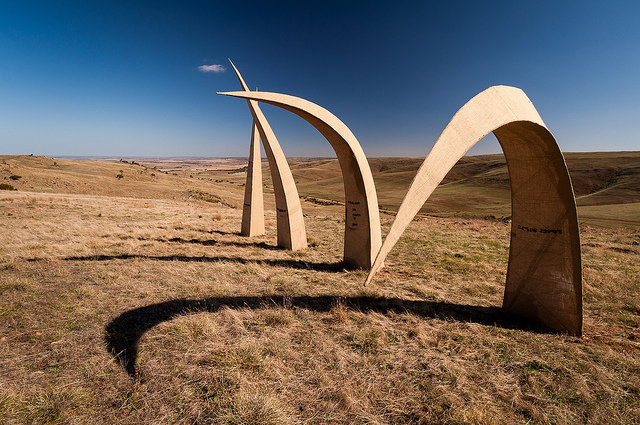PALMER SCULPTURE BIENNIAL, MARCH, 2014 – CALL FOR EXPRESSIONS OF INTEREST
Expressions of Interest are being invited for the Sixth Palmer Sculpture Biennial which will take place during the later part of the Adelaide Festival/Fringe, March, 2014.This year, we are honoured to have Ken Scarlett, our best known writer on Australian sculpture as co-curator with Greg for the 2014 Biennial.
About twenty five artists will participate from South Australia, interstate and overseas, including an invited senior and two emerging artists. The Palmer Project
In 2001 Adelaide sculptor Greg Johns purchased a former sheep grazing property at Palmer, in the rain shadow of the Mount Lofty Ranges, about 70 km east of Adelaide. Greg has two main aims for the place: the display of a collection of his own works and a range of other contemporary sculpture, and the ecological rehabilitation of the property. Adelaide artist Gavin Malone, who has assisted Greg in the exhibition program and sustainability discourse as joint coordinator of the Palmer Project, has recently stepped aside to concentrate on his own work, and the administrative aspects of the Project have been taken up by Bill Clifford, a community project management consultant. The broader art and ecological aspects of the Project are evolving as a microcosm of the range of issues pertinent to the relationship between art and ecological and social sustainability.
The small township of Palmer sits at the base of the foothills of the eastern escarpment of the Mount Lofty Ranges, from where the land slopes towards the River Murray, about 18km to the east. The Aboriginal people and traditional custodians of country are the Peramangk and the area has a rich Aboriginal history.
This region is the edge of the mallee country, the rainfall being 400 mm (16 in.) per annum and is used for mixed farming, cropping and grazing. The indigenous flora of the area has been almost entirely cleared since European settlement with just patches of remnant vegetation.
Palmer Sculpture Biennial
The first five Biennials have attracted healthy attendances, well beyond our initial expectations, including many interstate and overseas visitors. The first Biennial in 2004 featured 9 artists and 400 visitors attended. The 2006 event was recognised by the Adelaide Fringe, receiving an award for best group visual arts exhibition during the Adelaide Fringe and also an Advertiser Oscart for best outdoor exhibition of 2006 (The Palmer Project has also received four SA Great nominations in the categories of art and science/environment). This time, 23 artists participated and over 650 visitors attended.
Twenty three artists participated in the 2008 Biennial, with the invited artist being South Australian sculptor, Ted Jonsson. This event occurred during a record breaking heat wave (15 days above 35°, several above 40°), and as a result, after an attendance of 200 on the first day, visitor numbers declined. Consequently, future events have been pushed back a couple of weeks. We had better weather for the 2010 exhibition which further established the Biennial, not only on a national but also international level as an event of high quality, artists from England, Germany and Holland making a valuable contribution, complementing the work of the Australian artists. It featured 24 artists and was attended by 480 people.
The 2012 exhibition continued to attract significant artists from South Australia, interstate and overseas. Good weather during open days encouraged 600 visitors to come and see the works of the 24 participating artists. The opening event has become a particular attraction, incorporating food, wine, speeches and veranda music in addition to the unique experience of engaging with works of sculpture against the background of the Palmer hills.
The Biennial has received significant publicity at both state and national levels. It has been pleasing to see events such as Sculpture by the Sea exhibiting sculptors from the Palmer Biennial. We feel the Biennial has established itself as a major event, exhibiting a broad range of sculpture in a situation where the artists determine their approach.
The Palmer Sculpture Biennial is and will remain an artist run event, the mutual support surrounding the event has been enjoyed by everyone and is a major contributor to its success. An informal self catered artist’s dinner is held on the property as part of the event. There is an ‘artist’s award’ for the best works based on peer recognition for which the artists contribute $10 each. Artists will be asked to contribute to a staffing roster and other organisational activities, for instance opening day catering, publicity and promotion etc. The event has received private sponsorship which has enabled the production of a high quality catalogue and to meet some other overhead costs and it is expected this will continue. Artists meet all costs involved with exhibiting their works (including travel). Works can be made available for sale (reasonable commission applies) and significant sales have occurred.
Expression Requirement
The requirement to express interest in the event is the submission of a concept outline with supporting drawing/documentation on an A4 page/s after a visit to the site. Interstate/overseas artists should discuss alternatives to this requirement with Greg. See www.palmersculpturebiennial.org for images of previous works (images from the 2012 Biennial are currently being loaded but should be viewable well before mid March). Times will be arranged for artists who haven’t already been to Palmer to visit in groups, and to register for this please contact us. Submissions can be made by email to palmersculpturebiennial@gmail.com, or by mail to Greg, 2 Mary St, Eden Hills, SA 5050.
Expressions of Interest are required by Monday 10th June, 2013. We will advise participation as soon as practicable after then.
For further information, please contact Greg by email, (gjoh4899@bigpond.net.au) or phone (08) 8278 3273; or Bill, email (jandbclifford@internode.on.net) or phone (08) 8398 0868. You may also visit our website, palmersculpturebiennial.org.
Regards
Greg Johns and Bill Clifford March 2013
![greg johns - guardian figures [on property] mild steel](/wp-content/uploads/2013/03/6897656494_bf43761118_z.jpg)
![Ted Jonnson - Birdman [from 3rd biennial 2008] mixed media, bicycle frame - photography Bill Doyle](/wp-content/uploads/2013/03/7043797213_35739b0fbc_z.jpg)
